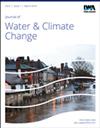Analyse of past and projected changes in extreme precipitation indices in some watersheds in côte d'Ivoire
IF 3.1
4区 环境科学与生态学
Q2 WATER RESOURCES
引用次数: 0
Abstract
The purpose of this study is to analyse trends in annual rainfall extremes over five watersheds within Côte d'Ivoire using observed data (1976–2017) and projected (2020–2050) rainfall data from the fourth version of the Rossby Centre regional atmospheric model, RCA4, for the representative concentration pathways RCP 4.5 and RCP 8.5. Four rainfall extreme indices, namely, the consecutive dry days (CDD), maximum annual rainfall (Pmaxan), very wet day (R95p), and maximum 5-day rainfall (Rx5days), were considered for trend analysis by using the non-parametric modified Mann–Kendall test and the distribution mapping bias-correction technique to adjust the simulated regional climate model climate of the simulated daily precipitation. As a result, it is found that during the period 1976–2017, there was a significant downward trend in the drought-related index (CDD) at the Bagoue, Baya, Agneby, and Lobo watersheds. The Baya and N'zo watersheds also experienced a significant downward trend under the RCP 4.5 and RCP 8.5 scenarios. The flood-related indices (Pmaxan, R95p, and Rx5days) show a clear downward trend in the recorded data for almost all the considered watersheds and generally a significant upward trend for both cases. These findings indicate that the watersheds are vulnerable to climate-induced disasters.分析科特迪瓦一些流域极端降水指数的过去变化和预测变化
本研究的目的是利用观测数据(1976-2017 年)和第四版罗斯比中心区域大气模型 RCA4 针对代表性浓度路径 RCP 4.5 和 RCP 8.5 预测的降雨数据(2020-2050 年),分析科特迪瓦五个流域的年极端降雨量趋势。利用非参数修正的 Mann-Kendall 检验和分布图偏差校正技术调整模拟日降水量的模拟区域气候模式气候,对连续干旱日(CDD)、最大年降水量(Pmaxan)、极湿日(R95p)和最大 5 日降水量(Rx5days)四个降水极端指数进行了趋势分析。结果发现,1976-2017 年期间,巴古埃流域、巴亚流域、阿格尼比流域和罗布泊流域的干旱相关指数(CDD)呈显著下降趋势。在 RCP 4.5 和 RCP 8.5 情景下,巴亚和恩佐流域也出现了明显的下降趋势。几乎所有流域的洪水相关指数(Pmaxan、R95p 和 Rx5days)在记录数据中都显示出明显的下降趋势,而在两种情况下一般都有显著的上升趋势。这些发现表明,这些流域很容易受到气候引起的灾害的影响。
本文章由计算机程序翻译,如有差异,请以英文原文为准。
求助全文
约1分钟内获得全文
求助全文
来源期刊

Journal of Water and Climate Change
WATER RESOURCES-
CiteScore
4.80
自引率
10.70%
发文量
168
审稿时长
>12 weeks
期刊介绍:
Journal of Water and Climate Change publishes refereed research and practitioner papers on all aspects of water science, technology, management and innovation in response to climate change, with emphasis on reduction of energy usage.
 求助内容:
求助内容: 应助结果提醒方式:
应助结果提醒方式:


